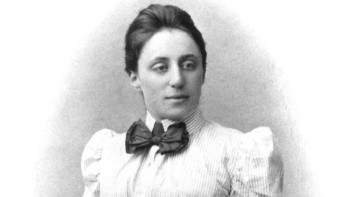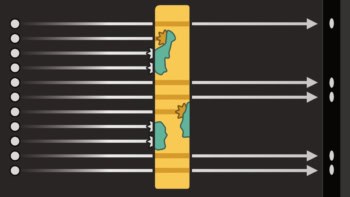Some 100 years after the father of the uncertainty principle was born, historians of science continue to debate the role that Werner Heisenberg played during the Second World War

Read any account of the development of physics in the early 20th century and you will almost certainly discover that a stay in Germany was de rigueur for any aspiring young physicist. One German physicist who became famous as the teacher of a generation of outstanding pupils was Arnold Sommerfeld. In the summer of 1922, shortly after the young Werner Heisenberg came under his tutelage, Sommerfeld wrote to Paul Epstein, a former student who had since become professor of theoretical physics at the California Institute of Technology: “I expect enormous achievements by Heisenberg, who I think is the most gifted one among all my pupils, including Debye and Pauli.” Just 10 years later, Heisenberg was awarded the Nobel Prize for Physics for the “creation of quantum mechanics”. The Nobel committee summed up Heisenberg’s merits in a nutshell.
But why is Heisenberg still controversial 100 years after his birth? In his recent monograph, Heisenberg and the Nazi Atomic Bomb Project, the American historian Paul Rose raises serious doubts about Heisenberg’s personal morality. He is described as a wildly emotional and ambitious man who was “unable to break out of German anti-Semitic mentality”. Scientifically, too, he is blamed for misconceptions.
Bad physics and bad morals, according to Rose, culminated in Heisenberg’s flawed contribution to the Nazi atomic-bomb project, the failure of which was later fabricated as a deliberate effort to sabotage the project. Moreover, Rose believes that the German mentality of Heisenberg and his friends, fertilized by astounding powers of self-delusion and rationalization, spun the web of self-deception that led to Heisenberg’s version of events. And he blames this combination of fabrication and denial for the confusion about Heisenberg’s work on the atomic bomb that persists to the present day.
Heisenberg’s life has offered rich pickings for historians of physics. David Cassidy has written an authoritative biography, Uncertainty: the Life and Science of Werner Heisenberg, that provides a coherent and convincing view of the most disputed topics of Heisenberg’s life until the end of the Second World War. Meanwhile, the story of the German atomic-bomb project – if it can be so called – has been told by historian Mark Walker and others (see further reading).
But the controversy surrounding Heisenberg continues, perhaps because his life does not lend itself to simple answers. As well as uncertainty, complexity is another physical concept that serves as a metaphor for Heisenberg’s life. After all, we know that the physics of a complex system cannot be understood simply from the collective behaviour of its individual parts. Rather than examine preconceived opinions about the German physicist, we should aim to take a holistic perspective of his life as we attempt to understand him better.
Werner Karl Heisenberg was born on 5 December 1901 in Würzburg, northern Bavaria, and moved to Munich at the age of nine when his father became a professor of Greek studies at the university. In his biography, Cassidy details the social context in which Heisenberg’s early life was rooted. What seems, at first, to be a marginal episode in his formative years – participation in a youth group called Pfadfinder (Pathfinder) – turns out to be a clue to understanding Heisenberg’s behaviour after the First World War.
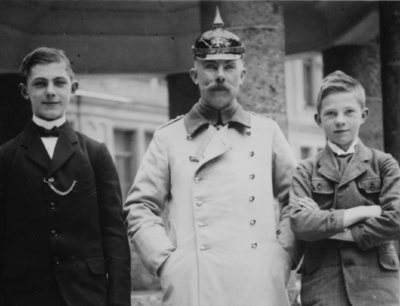
The years of “pathfinding” after 1919 were those in which Heisenberg was acutely aware of his social environment. Here we find the elements that formed his personal values: rebellion against non-ideal values, such as capitalism, materialism, hypocrisy and moral decadence; adherence to a close circle of likeminded friends united in a “harmony of souls”; a love of nature; and a deeply felt affinity with German culture.
Some of these ideals were not far from the emerging Nazi ideology. Nationalism, although not an explicit Pathfinder virtue, was certainly appreciated by most of the members as an obvious obligation to their country. Teutonic rituals – some of which involved sitting around a camp fire dreaming of a mystical “third Reich” and a magical white knight who symbolized German virtues – featured in some Pathfinder ceremonies. Anti-Semitism, too, was a recurring theme, albeit a disputed one: the Munich Pathfinder contingent split into pro-Jewish and anti-Semitic factions. Moreover, the trust in a Führer as a revered leader of a group was widespread among Pathfinders. Despite such similarities, however, it would be quite misleading to identify Pathfinder ideals with Nazism.
Heisenberg’s affiliation with the youth movement was not a short-term flirtation between boyhood and manhood. He became the leader of a boy group at the age of 17. Gruppe Heisenberg, as it was called, was integrated into a larger troop in which teachers and high-school students were the leaders and group members. In the spring of 1919 the troop actively participated in paramilitary operations against the Munich Soviet Republic – a short-lived attempt to establish a communist regime after revolutionary turmoil at the end of the First World War. These activities, together with the experiences from the First World War that the teachers passed on to their pupils, formed the basis from which the troop set out to renew society. Many of the members shared a fundamental anti-political stance. As a group of highly educated, middle- and upper-class young men, they felt elitist and above plain party politics.
Heisenberg’s case was typical, both with respect to his social roots and to his politics. “I never thought that I could interest myself in politics,” he wrote to a Pathfinder friend in 1923, “because it seemed to me to be a pure money business.” Although the organizational structure of the Pathfinder groups changed over the years, Heisenberg remained firmly committed to the members of his group even after he published his famous paper on quantum mechanics in 1925. They continued to meet once a week in Heisenberg’s home. And at weekends they went on trips to the Alps or to a lake near Munich, where they would sail, play ball games, throw spears and take part in other competitive sports. Indeed, according to Cassidy, the incredible intensity of Heisenberg’s work during the early 1920s was possible only because he could relax completely during these outings. Heisenberg had few friends or even acquaintances outside his youth movement.
Pathfinding was important in another respect. “In addition to many other values, we also discovered science anew,” Heisenberg wrote years later. He focused on areas of science that were rather remote from application, perhaps because his comrades branded science, and physics in particular, as “mechanic materialism”. As he recalled: “Even in science our interests concentrated on those fields in which it was not simply a question of the further development of what is already known.” As a result, Heisenberg preserved a life-long interest in exploring fundamentally new approaches in physics – where success was uncertain – rather than pursuing research along established paths.
University challenge
When Heisenberg entered university in October 1920, physics was not his first choice. Having been brilliantly successful at high school, he intended to study mathematics and to launch immediately into advanced research. Indeed, Heisenberg’s father arranged an appointment with the famous mathematician Ferdinand von Lindemann in the hope that his ambitious son would be admitted into Lindemann’s class where he would begin advanced research straight away. But the interview did not go well for young Heisenberg. Lindemann, who was then 68 and partially deaf, barely understood what Heisenberg said. And from what he did understand, he concluded that the young man’s unorthodox approach to mathematics was not to his taste.
Heisenberg’s second attempt to obtain access to advanced study without the usual preliminaries led him to Arnold Sommerfeld, professor of theoretical physics at Munich. Experienced with exceptional students, Sommerfeld, who was then 52, responded differently: “It may be that you know something; it may be that you know nothing. We shall see.”
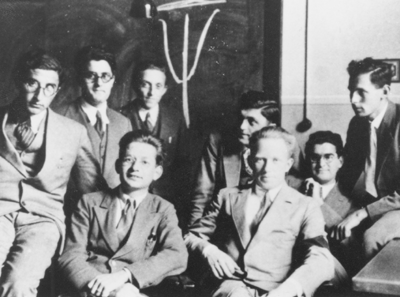
Heisenberg could not have found a more appropriate home for his ambitions. Here he met congenial students, like Wolfgang Pauli, then 20 years old and in his fifth semester. Indeed, the names of Sommerfeld’s pupils reads like a Who’s Who of modern theoretical physicists: Alfred Landé, Peter Paul Ewald, Karl Herzfeld, Gregor Wentzel, Otto Laporte, Adolf Kratzer and Wilhelm Lenz, to name only those with whom Heisenberg became acquainted during his early studies.
At the time Sommerfeld was deeply immersed in atomic theory. In 1915 he had extended Bohr’s atomic model by taking the theory of special relativity into account and by quantizing both the azimuthal and radial motion of orbiting electrons. A year later, he also quantized the orientation of the electronic orbit. He was able to calculate electronic energies, which gave rise to additional terms in atomic spectra. This fine structure was verified by the spectroscopist Friedrich Paschen with whom Sommerfeld corresponded intensively during the First World War. Sommerfeld’s classic treatise Atomic Structure and Spectral Lines, first published in 1919, went through four editions during Heisenberg’s time at Munich, indicating the rapid progress being made in atomic theory during those years.
Surrounded by like-minded students and guided by a revered leader, Heisenberg felt as intellectually at home in Sommerfeld’s group as he had felt emotionally at home within his Pathfinder group. Sommerfeld soon came to appreciate the talents of his new pupil. In 1922 he made the 21-year-old Heisenberg co-author of two papers on the atomic theory of X-ray spectra and the so-called anomalous Zeeman effect.
The splitting of spectral lines in a magnetic field had been observed some 25 years earlier by the Dutch physicist Pieter Zeeman, and was explained by the interaction of the angular momentum of the orbiting electrons with the external field. The observation of additional splitting, however, was a major riddle in the early days of quantum mechanics and was later recognized to be a consequence of the intrinsic angular momentum or “spin” of the electron.
In 1921 Sommerfeld agreed that Heisenberg could publish a paper on the anomalous Zeeman effect, although he was sceptical about the physical foundation of Heisenberg’s theory. “His Zeeman model generally meets with opposition, particularly with Bohr,” Sommerfeld wrote in a letter to Epstein. “But I find its success so enormous that I held back all my reservations with its publication.” Heisenberg’s model involved half-integer quantum numbers, which he attributed to the atomic core. However, his model did agreed with Landé’s empirical results on the splitting of spectral lines in magnetic fields and, crucially, broke the dogma of integer quantum numbers.
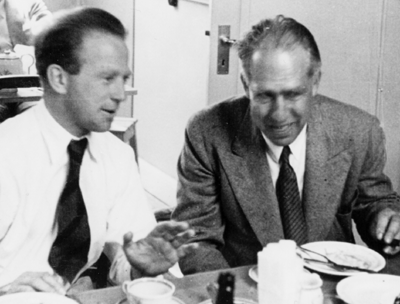
In the summer of 1922 Heisenberg met Niels Bohr for the first time and confronted him with his unorthodox ideas about atoms. The meeting took place during a week of lectures by Bohr in Göttingen – the “Bohr festival” as is it became known – and transformed Heisenberg into a well known figure within the small community of atomic theorists.
But Heisenberg did not specialize in atomic theory and his second publication was about alternating vortices in fluids called Kármán vortices. Indeed, Sommerfeld and his pupils repeatedly addressed problems in fluid dynamics, such as the transition from smooth laminar flow to turbulence. It should therefore come as no surprise that Heisenberg’s doctoral dissertation was on fluid flow, rather than atomic physics.
On the road to quantum mechanics
Before Heisenberg finished his studies at Munich in 1923, he spent six months at Max Born’s institute in Göttingen. Born had just started an ambitious research programme in atomic theory, exploring perturbation methods from celestial mechanics in an attempt to deal with many-body problems in atoms by analogy with those in classical mechanics. This research resulted in a collaboration between Heisenberg and Born on the theory of the helium atom. Born also proposed that Heisenberg should come to Göttingen as his assistant after finishing his studies in Munich. But Heisenberg’s doctoral examination almost resulted in disaster. He could not answer experimentalist Wilhelm Wien’s questions about the resolving power of optical instruments and how a storage battery works. Wien only let him pass after Sommerfeld vigorously defended his pupil.
After this traumatic event, Heisenberg was glad to escape to Göttingen where he focused entirely on atomic theory. Within a few months he had qualified as a lecturer following the publication of a paper in which he modified the rules of quantum theory to address the anomalous Zeeman effect. In September 1924 he interrupted his stay at Göttingen and went to Copenhagen, where Bohr had invited him as a research associate. In Copenhagen, Heisenberg’s research focused on the quantum theory of radiation. Bohr, his Dutch assistant Hendrik Kramers, and a visiting American research fellow, John Slater, had worked out a semi-classical theory, which became known as BKS theory. But the hypothesis soon met with serious difficulties and was abandoned.
According to classical dispersion theory, atoms respond to electromagnetic fields by oscillating at the frequency of the absorbed or emitted radiation. Such a theory, however, could not account for the quantum features of the Bohr atom and the particle-like behaviour of radiation in certain circumstances. The BKS modification of classical dispersion theory was still classical, in as far as it assumed that electromagnetic radiation was wave-like and did not involve quanta, although it did account for quantum jumps.
The remedy was a “virtual radiation field”, a sort of ghost field containing the possible frequencies for the quantum transitions of an atom in a given stationary state. Although it violated established physical principles, such as causality and energy conservation, the virtual field suggested a new mathematical framework for connecting the classical and quantum worlds. It therefore became the subject of intense scrutiny by Born and Heisenberg when the latter returned to Göttingen. This was the conceptual prerequisite from which Heisenberg conceived his quantum mechanics. His decisive contribution to this programme was his paper “On a quantum theoretical re-interpretation of kinematical and mechanical relationships”, now considered to be the breakthrough in modern quantum mechanics.
Heisenberg’s paper marked a radical departure from previous attempts to solve atomic problems by making use of observable quantities only. “My entire meagre efforts go toward killing off and suitably replacing the concept of the orbital paths that one cannot observe,” he wrote in a letter dated 9 July 1925. In this respect, his work went far beyond Born’s efforts to achieve a discrete quantum analogue of atomic mechanics. Rather than struggle with the complexities of three-dimensional orbits, Heisenberg dealt with the mechanics of a one-dimensional vibrating system – an anharmonic oscillator. And he explored the behaviour of the observable quantities – the radiation frequencies – that, according to the BKS legacy, had emerged from the “virtual oscillators” of an atom.
The result was formulae in which quantum numbers were related to observable radiation frequencies and intensities. Born noticed that Heisenberg’s formulae could be expressed in a concise manner using matrices. For this reason, the new theory also became known as “matrix mechanics”.
Rapid rise of quantum mechanics
Following Heisenberg’s breakthrough, quantum mechanics took shape at an amazingly rapid pace. Born, together with his new assistant Pascual Jordan, reshaped Heisenberg’s work into a systematic matrix formulation, highlighting the relationships between “conjugate variables”, such as momentum and position, and energy and time. In quantum mechanics, these relationships became commutation relations between conjugate matrices.
Meanwhile Paul Dirac, quite independently from the Göttingen group, presented quantum mechanics in a new language of operators. In Zurich, Erwin Schrödinger took a different approach and in 1926 developed wave mechanics – another form of quantum mechanics, which was found to be equivalent to the matrix method.
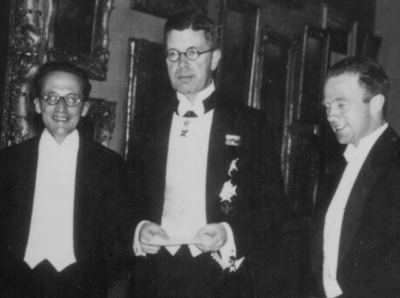
In 1926 Heisenberg succeeded Kramers as Bohr’s assistant in Copenhagen. Having been raised in Sommerfeld’s school and collaborated with Born, Heisenberg was familiar with the guiding spirits of quantum theory like few others. Working in Bohr’s institute, he formulated the principle of uncertainty in March 1927, thereby laying the foundation of what became known as the Copenhagen interpretation of quantum mechanics.
Soon afterwards in October 1927, at the age of 26, he became professor for theoretical physics at the University of Leipzig. Within a few years, Heisenberg established Leipzig as a new centre of modern theoretical physics, together with another Sommerfeld pupil, Peter Debye, who held the chair for experimental physics, and Friedrich Hund, who became extraordinary professor for theoretical physics in 1929.
By the early 1930s a new generation of theorists – such as Felix Bloch, Rudolf Peierls, Edward Teller, Victor Weisskopf and Carl Friedrich von Weizsäcker – had spread the gospel of the new “Heisenberg school”. Students and research fellows from all over the world were attracted to Leipzig, including Ettore Majorana from Italy, Laszlo Tisza from Hungary, and Seishi Kikuchi, Shin-Ichiro Tomonaga and Satoshi Watanabe from Japan. Many of them earned their first academic laurels under Heisenberg’s tutelage by applying quantum mechanics to solid-state physics, then a primary target for solving old problems with a new tool.
Heisenberg himself paid some tribute to the emerging quantum-mechanical theory of solid-state physics by solving the riddle of ferromagnetism, but his main interest was in exploring new areas, rather than applying established methods. He focused, in particular, on the emerging new field of high-energy physics – which in the era before particle accelerators meant cosmic rays and nuclear physics – where the ideas of relativistic quantum field theory could be compared with experimental observations (see Brown and Rechenberg in further reading).
The world is ugly, but the work is beautiful
“It is a pity,” Heisenberg wrote to Sommerfeld in February 1938, “that in a time when physics makes such wonderful progress and it is a pleasure to contribute to its further development, one becomes involved in politics again and again.” To keep himself aloof of politics was no longer possible after Hitler’s rise to power in 1933. Although Heisenberg, like many Germans, probably regarded Hitler’s nationalist zeal with some sympathy, he was appalled at the crudity of the regime when it came to practical measures, such as the purge of non-Aryan colleagues from universities.
In this situation, Heisenberg asked the grand old man of German science, Max Planck, for advice. Planck persuaded him that the physics profession would be better protected by quiet efforts behind the scenes than by open protest. “Planck has spoken – I think I can pass this on to you – with the head of the government,” Heisenberg wrote to Born, a Jew, in June 1933 after Planck had visited Hitler, “and obtained the assurance that nothing will be undertaken beyond the new civil service law that will impede our science.”
Although Born had not been officially dismissed, he had left Göttingen and was ready to emigrate. Even if he had been allowed to stay because of a special regulation that exempted the dismissal of Jews who had served in the First World War, Born saw no future for his children in Germany. “I would like to ask you not to make any decisions yet,” Heisenberg advised his former mentor, “but to wait and see how our country looks in the autumn.” Born ignored Heisenberg’s plea and emigrated to the UK where he stayed for 17 years before returning to Germany in 1953.
This “wait and see” strategy became a characteristic of Heisenberg’s reaction to politics. In 1935 he came closest to an open protest against the Nazi authorities when colleagues from the Leipzig philosophical faculty were dismissed in a second wave of purges. Heisenberg and others were dismayed, and expressed their disapproval at a faculty meeting. The only consequence of this background protest was a formal reprimand for the dissenters by the regional head of the Reich; the dismissals remained in force.
Appalled at politics once more, Heisenberg’s reaction was again to retreat. In a letter to his mother in the autumn of 1935 he wrote: “I must be satisfied to oversee in the small field of science the values that must become important for the future. That is the only clear thing left for me to do in this general chaos. The world out there is really ugly, but the work is beautiful.”
But retreat into science without politics was impossible for the renowned physicist. When Sommerfeld reached retirement age in 1935, Heisenberg was the obvious candidate to succeed him at Munich. But Nazi ideology was now raging in physics too: Johannes Stark and Philip Lenard, both Nobel-prize winners, characterized modern theories like relativity and quantum mechanics as “Jewish physics”. Stark complained publicly that although Einstein had left Germany for America, there were still physicists acting in Einstein’s spirit. Moreover, he protested that “the theoretical formalist Heisenberg, spirit of Einstein’s spirit, is now even to be rewarded with a call to a chair”. This was the start of a campaign against Heisenberg and Sommerfeld, which ended in 1939 when Wilhelm Müller was named as Sommerfeld’s successor. Müller, an aerodynamicist, was branded a “complete idiot” by Sommerfeld.
Heisenberg was driven to despair in the course of this struggle. Using private contacts between his and Heinrich Himmler’s families, he sought assurance from the Nazis that their official view of him was not the same as that expressed in the campaign waged against him. He even thought of emigrating when the investigation into his case seemed to last forever.
Behind the scenes, Heisenberg’s case – and the Nazi regime’s stance on physics in general – was evaluated differently by different groups. Himmler’s power troop, the SS, finally supported Heisenberg and modern theoretical physics for pragmatic reasons, while party leaders and Nazi university representatives emphasized ideology over utility. The fanatics among the physicists – often addressed as one group under the name “Deutsche Physik”, despite their diffuse tendencies – had been successful in preventing Heisenberg from succeeding Sommerfeld. But Heisenberg’s case marked the beginning of the end for their movement. With the outbreak of the Second World War, the Nazi regime valued the possible uses of physics higher than ideology.
The war years
Heisenberg gained government acceptance after the outbreak of the Second World War, and was entrusted by the Ministry of Education with the scientific directorship of the Kaiser Wilhelm Institute of Physics in Berlin, together with Otto Hahn. The institute was under the authority of the Army Ordnance Office because of its central role in co-ordinating a secret war project. Together with other nuclear scientists, who called themselves the Uranium Club, Heisenberg began investigating the possible wartime uses of Hahn’s discovery of nuclear fission. Such uses included nuclear reactors for submarine propulsion and the possibility of a new bomb that “surpasses the explosive power of the strongest explosive materials by several orders of magnitude”, as Heisenberg argued in an early report in December 1939.
To this day, physicists and historians of physics debate Heisenberg’s motivations and role in this effort. His compromises with the Nazi regime – perhaps psychologically explicable in view of his struggle to clear his name – raised doubts about his character. Thousands of pages have been written about “Heisenberg’s war”, but no consensus has been achieved.
According to one version, championed separately by the journalists Robert Jungk and Thomas Powers, Heisenberg deliberately delayed the project’s progress because he abhorred the thought of an atomic bomb in Hitler’s hands. But the historian Paul Rose has taken the opposite view. He believes Heisenberg tried hard to build an atomic bomb, but failed because he did not understand the physics properly. Heisenberg’s own version was that he and fellow scientists in the Uranium Club were spared the decision because they had not made enough progress due to the circumstances of the war.
Meanwhile, Mark Walker has criticized the “black or white” fashion in which this question has been answered. He argues that it was not Heisenberg’s competence that dictated the progress of the atomic-bomb project, rather that the Army Ordnance Office lost interest in it in 1942 because the project would not produce results soon enough to influence the outcome of the war. In his study, Nazi Science, Walker provides an answer, which is perhaps as close as one can approach the truth in this entangled matter. “Did the Germans try to build atom bombs?” he asks. On one hand, he argues the Germans did not invest billions of dollars in the construction of huge factories and the development of detonation devices. But they did manufacture substances that were known to be potential nuclear explosives as quickly as possible without hindering the war effort. There is no simple answer, he concludes.
The controversy goes on
Heisenberg’s life after the war has not generated as much interest, although it too provides room for controversy. Heisenberg failed to find the support of his fellow scientists when he tried to form an elitist German Research Council as the country’s central body for science policy. Although Konrad Adenauer, West Germany’s first chancellor, welcomed Heisenberg’s advice in atomic affairs, his role as a German “atomic tzar” met with derision from the first minister of atomic affairs, Franz Josef Strauss. Scientifically, too, his post-war research in particle physics was regarded with scepticism and seems to have been rather futile, contrary to the sensational newspaper reports that his “Weltformel” – his unified field theory of elementary particles – generated in 1958.
Strictly speaking, the controversy about Heisenberg’s behaviour during the Nazi era is also a postwar story. It began in1947 when the American physicist Samuel Goudsmit published Alsos, a grim account of the German nuclear war effort. Goudsmit used Heisenberg’s case to illustrate the failures of a dictatorship in directing science. In 1956, however, Heisenberg was portrayed as a moral icon for the first time in Jungk’s book Brighter Than a Thousand Suns in an era of Cold War and McCarthyism. Yet Walker later concluded that Jungk’s “conspiracy theory” was the product of a time when, once again, politics harmed science and scientists.
The controversy surrounding Heisenberg has come to the fore again with Copenhagen, a play centred around his visit to Copenhagen in 1941, where he met Niels Bohr and Bohr’s wife, Margrethe. Playwright Michael Frayn’s interest in Heisenberg was aroused after reading Powers’ book Heisenberg’s War, which portrayed Heisenberg – as Jungk had – as a hero who delayed research on the German atomic bomb. Heisenberg’s role in the play is less heroic, however, and his character is embedded in an artistic maze of uncertainties that allude to both quantum uncertainty and the historical uncertainty that exists as a result of the lack of documentary evidence about the meeting in 1941. Some new light may soon be shed on this issue with the forthcoming publication of Bohr’s letters (see Secret letters cast light on Copenhagen, Physics World November p9).
Frayn’s Heisenberg is not the “ugly German” that is portrayed by Rose, nor is he the hero in Jungk’s or Powers’ books. Playing with the uncertainty metaphor from past to present, within and beyond physics, Heisenberg’s life becomes metaphorical itself: a man under contradictory pressures, a symbol of what seems to be a principle far beyond the quantum realm. “What people say about their own motives and intentions, even when they are not caught in the traps that entangled Heisenberg, is always subject to question – as subject to question as what anybody else says about them,” Frayn concludes in his postscript to Copenhagen.
A new Heisenberg has entered the stage, now in the company of a post-modern Zeitgeist: “Thoughts and intentions, even one’s own – perhaps one’s own most of all – remain shifting and elusive,” according to Frayn. “There is not one single thought or intention of any sort that can ever be precisely established.”

